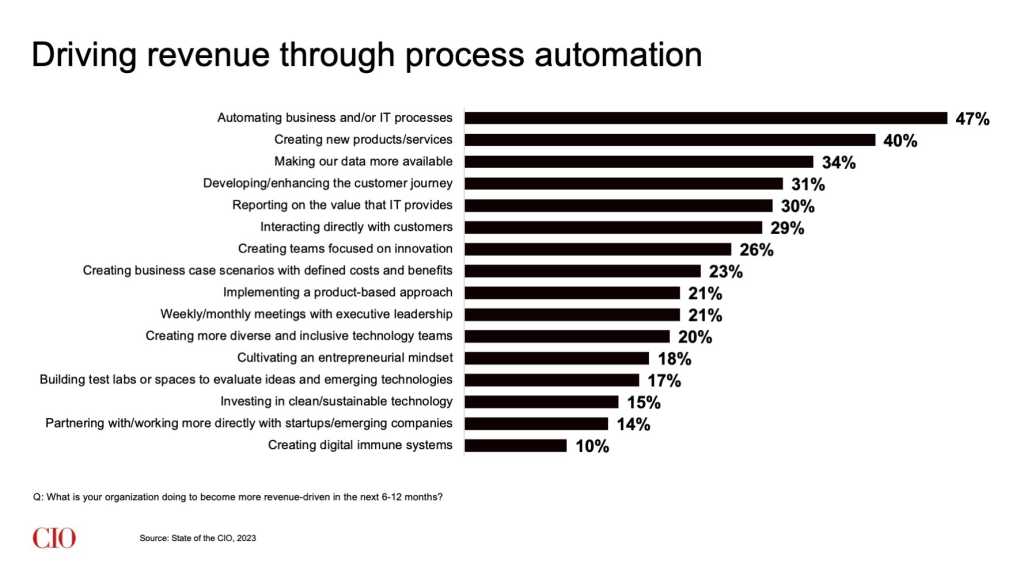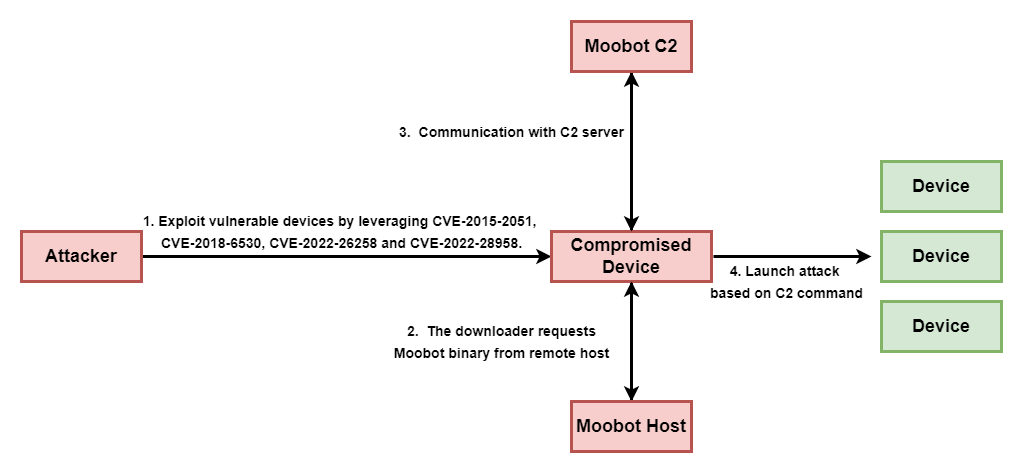How IT leaders are driving new revenue
Growth-focused activities
According to CIO.com’s State of the CIO Survey, 68% of CIOs say creating new revenue-generating initiatives is now part of their job.

Growth-focused activities
According to CIO.com’s State of the CIO Survey, 68% of CIOs say creating new revenue-generating initiatives is now part of their job. To that end, the survey identified the top 10 activities CIOs are undertaking to help drive more revenue to their business as:
- Automating business and/or IT processes (47%)
- Creating new products/services (40%)
- Making our data more available (34%)
- Developing/enhancing the customer journey (31%)
- Reporting on the value that IT provides (30%)
- Interacting directly with customers (29%)
- Creating teams focused on innovation (26%)
- Creating business case scenarios with defined costs and benefits (23%)
- Implementing a product-based approach (21%)
- Weekly/monthly meetings with executive leadership (21%)
Of note, too, is No. 12: Cultivating an entrepreneurial mindset, with 18% listing that as one of their priorities.
CIOs in recent years have created the bandwidth they need to focus on revenue and growth, by offloading application and infrastructure management to software-as-a-service and cloud vendors, says Shankar Narayaran, president and global head of retail, CPG, travel, and hospitality at Tata Consultancy Services.
At the same time, he says CIOs who moved to the cloud and deployed capabilities such as low-code platforms, which enable business unit workers to create software features, created the technology foundation necessary for CIOs to deploy the more advanced tech tools and niche functions that directly support revenue-generating processes.
CIOs who are driving new revenue are:
Delivering technologies designed to meet specific business outcomes. For example, Narayaran has seen CIOs focus their teams on creating applications designed not merely on high availability and reliability but on hitting very specific business goals — such as enabling on-time deliveries to its customers.
Unlocking data’s potential. Narayaran says he has also seen CIOs make big plays with their data programs, investing in the technology infrastructure needed to bring together and analyze data sets to create new services or products and drive business objectives such as improved customer retention and customer stickiness.
Co-creating with their business unit colleagues. Notably, Narayaran says CIOs are approaching their business unit colleagues with such proposals. “CIOs [are saying], ‘Here’s an opportunity. We have this data, and we can make this data do this for you,’ and they then bring that to life. And if they say, ‘This is what we have and this is what we can do,’ then the business, too, can come up with new ideas.”
Embedding themselves in the business. Herlihy draws on the principle of “genchi genbutsu,” or “go and see for yourself” in Japanese. In other words, walk in your own customer’s shoes. Herlihy worked in a Subway shop before taking his seat in the CIO office, and he asks his team to gain such experience, too. He leaned into the principle in 2022, when he traveled to the United Kingdom and several European countries to explore whether deploying self-order kiosks would work in that market; the trip and a subsequent successful pilot demonstrated that enabling such high-tech kiosks would indeed help with sales. (He shares: “Guests will upsell themselves when they’re in front of a well-presented display of our products.”)
Seek out opportunities. “IT should always be viewed as more than ‘order-takers’ because we are a critical part of the revenue generation lifecycle,” says author and global technology leader Rhonda Vetere, who previously worked as both a CIO and a chief information and technology officer. Vetere says CIOs should identify opportunities where they can work with other functional leaders on revenue-focused initiatives. She cites as examples her work on redesigning a consumer brand website to incorporate a loyalty program and clicks-to-purchase — moves that drove sales, and thus, revenue growth — as well as bringing design thinking to make online banking more efficient for the banks’ customers. She adds: “Always go back to the company strategy and goals — the top business priorities should correlate with the activities of IT and areas of focus.”
Ted Schadler, a vice president and principal analyst with Forrester, whose work has focused on tech’s new role in growth, says “empowered CIOs” enable growth by flawlessly scaling and securing customer solutions, create growth by collaboratively building products that open new markets, and amplify growth by elevating insights, automation, and algorithms to optimize everything.

Foundry / CIO.com
More work to do
How much of a CIO’s time is spent on growth-focused activities varies by industry and by company, Schadler says.
But CIOs are well positioned to collaborate on growth initiatives because, unlike most other enterprise roles, they see across the enterprise and “can see patterns that lie outside of any single product,” Schadler says. He recounts how the CIO at a medical device company worked across four business units building an IoT platform to power the various products all four were seeking, work the CIO was able to unify because of the visibility he had.
Schadler says not all CIOs are empowered to do that work.
“They’ve been told they can’t, so they don’t,” he says, adding that he believes CIOs have the skills, knowledge, and practices — such as agile development — to successfully move into growth activities.
“But we hear stories that once they do, the engine just cranks up,” he adds.
In fact, Schadler says a growing number of CIOs are indeed venturing into such work; however, they remain part of a small percentage whose role is tied in with revenue. When Forrester asked CEOs, CTOs, and CIOs whether they were personally familiar with revenue growth as a business objective, only 18% of CIOs agreed (compared to 28% of CTOs and 35% of CEOs).
Tanowitz says he, too, sees some CIOs struggle to take on more revenue-generating activities. Yet, like Schadler, he also sees more CIOs growing into that work.
The CIOs who are moving into that space are developing a product-centric mindset and IT culture. They’re embracing agile and DevSecOps to enable their companies to quickly address market needs, “which does drive revenue,” Tanowitz says. And they’re building strong data, analytics, and intelligence programs to support the creation of new products and services.
“I think it’s on the CIO to lay out a vision and engage the organization on the value the CIO can bring,” Tanowitz adds.









